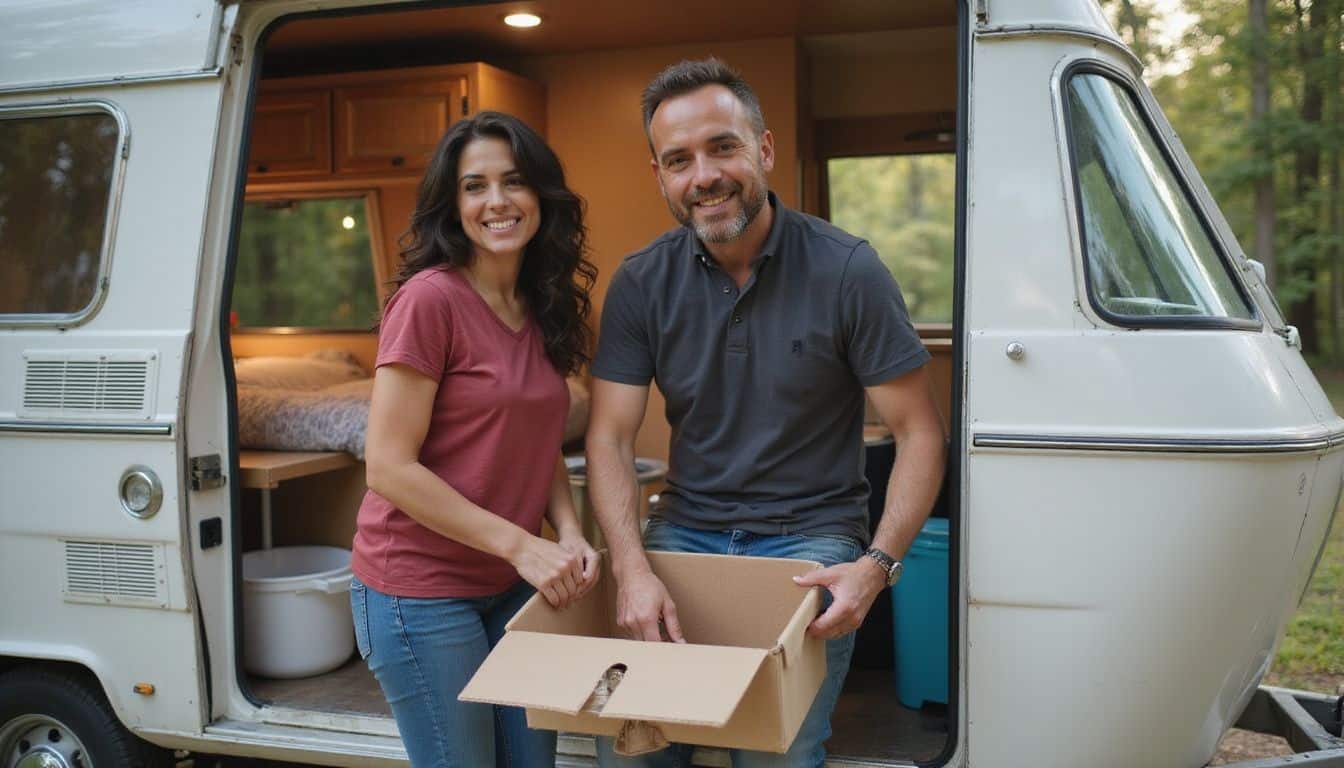Are you dreaming about how to live in a travel trailer full time but worried it’s too hard or expensive? Authors Jesse and Rachael Lyons have made this move from an apartment to their cozy fifth-wheel camper, living on the road for nearly three years.
Our guide shares 9 smart hacks—from managing RV expenses to tips about campgrounds—to help you make trailer life simpler and stress-free. Keep reading for clever ways to start your own RV lifestyle adventure!
Key Takeaways
Start downsizing your stuff early—space in a travel trailer is tight, so you’ll want to get smart with storage ideas like vacuum-sealed bags or furniture that works double duty.
Focus your financial plan on campsite fees, RV maintenance, fuel for travel, and special insurance called “full-timer coverage“, which keeps your mobile home secure.
Earn money as you go by exploring remote jobs, seasonal gigs, healthcare contracts, or “workamping” positions where RV parks pay you with cash or free stays.
Resource management matters a lot: watch how much water you use, set up solar panels to power up your trailer, and consider compost toilets instead of dealing with messy waste tanks.
Choose from private RV parks with monthly rates around $400 to $1,000 and comfy amenities, or camp for free on public land for up to two weeks—apps like Campendium make finding your next spot easier.
Table of Contents
Preparing for Full-Time Travel Trailer Living
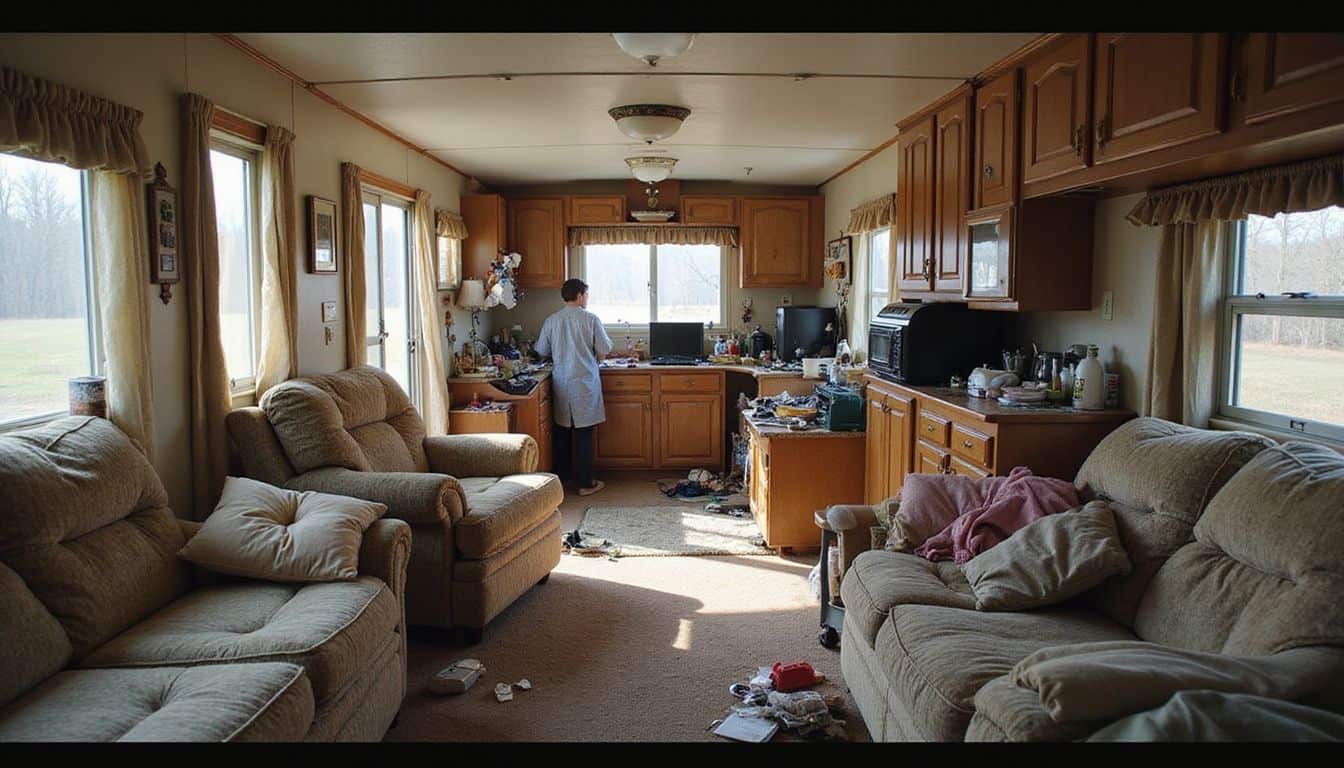
Getting ready for life on wheels means making smart choices about your space and stuff. Your prep work now will pay off with a smoother, happier travel life later.
Downsizing your belongings

Downsizing usually begins sooner than you’d expect. Jesse and Rachael Lyons discovered this firsthand—they moved from their tiny, 225-square-foot apartment straight into a travel trailer.
Sorting through your belongings is a big deal, since kitchen counters won’t fit all your appliances, and storage space shrinks drastically once inside an RV. Set up a clear timeline, and you’ll avoid feeling stressed or rushed as you trim down.
Photos often become handy substitutes for the large keepsakes your motorhome can’t handle. Before selling or donating sentimental items, snap a quick picture to save the memory, minus the clutter.
Clever storage ideas quickly turn into your greatest allies for living full-time in an RV. Vacuum bags for clothing, sturdy storage bins, and furniture with many uses will help you squeeze the most out of limited spaces.
Online RV groups frequently trade advice and helpful tips—creative storage ideas—to keep your place organized and cozy.
Choosing the right travel trailer

After sorting through your belongings, choosing the ideal travel trailer is your next important decision. Picking the right trailer truly shapes your full-time RV life experience. I spent three months cramped in a tiny trailer before upgrading—and believe me, having enough space is crucial!
Jesse and Rachael Lyons comfortably live full-time in their 2006 Keystone Laredo Fifth Wheel, proving older RV models can still offer reliable comfort with regular care. Renting a trailer first gives you a chance to test out features and find what really fits your needs.
Brands such as Grand Design, Alliance, and DRV offer quality builds and solid suspension systems worth checking out. Prioritize features you’ll actually use, such as a practical kitchen setup, ample storage, and solid insulation suitable for every season.
Find a rig that genuinely fits both your preferred camping style and your budget, steering clear of the stress of becoming “RV poor” by choosing a trailer below your maximum affordable price.
Your future home on wheels needs to reflect real-life necessities, not just fun extras.
The perfect travel trailer isn’t the most expensive one—it’s the one that fits your lifestyle while keeping you out of debt. – Full-time RVer
Renovating or customizing your trailer

Our trailer renovation lasted three months, but the outcome was totally worth every moment. We first ripped out the old carpet—and found a surprising infestation of ladybugs hiding underneath.
To give our tiny kitchen area a cozy, warm vibe, we installed sleek butcher block countertops. Painting the walls and cabinets bright white made our small space feel open, airy, and larger than before.
Careful space planning became our biggest strength during this renovation. To fit our king-size mattress—an essential comfort for full-time RV living—we removed the built-in closets completely.
For our pets, we designed custom areas—a built-in kennel for our dog, and even a special tunnel where our cat could play and relax. The new flooring handles daily use far better than the old carpet ever did.
RV community forums offered tons of helpful tips to tackle tricky problems, especially while dealing with tight spaces.
Financial Planning for Full-Time Travel Trailer Living

Living in a travel trailer full-time needs smart money planning. Your budget must cover not just campsite fees but also RV repairs, fuel costs, and insurance for your mobile home.
Budgeting for expenses
Handling your money carefully makes a big difference if you live full-time in a travel trailer. Expenses pile up quickly—Peggy Dent notes costs can climb as high as $5,000 each month.
Your monthly budget needs room for internet, phones, groceries, fuel, electricity, laundry, and park passes. Smart RV owners rely on easy apps or basic spreadsheets to track spending and view their finances clearly.
RV club memberships are also handy; they can offer valuable campground discounts to stretch money further.
The freedom of RV life comes with financial responsibility—track your spending and adjust your plans accordingly.
To save even more, try boondocking instead of staying at paid campsites. Free camping, often available on Bureau of Land Management properties, helps cut spending while providing beautiful scenery.
Many full-time travelling couples regularly check their budgets to find areas where they can cut back.
Maintenance tasks like emptying your black tank and unexpected RV repairs also deserve a set line in your monthly budget; these expenses occur often and get expensive quickly without planning.
Managing income on the road
Earning money while living in your travel trailer gives women an amazing sense of freedom. Remote jobs only require a laptop and Wi-Fi—ideal for life on wheels. Online writing assignments let me set up my workspace wherever I park, even next to breathtaking mountains! Many RV travelers take seasonal jobs that pay nicely and often come with perks, like scenic locations.
Selling handmade items or vintage goods through Etsy and eBay can provide regular income, without needing a permanent address. Another popular choice is workamping, where you exchange a few hours performing tasks at RV parks for free or discounted parking—potentially saving hundreds of dollars every month.
Traveling nurses and other healthcare workers also frequently take short-term assignments nationwide, easily living in their comfortable trailers. Social media management is another flexible role you could easily handle on the road, letting you earn money while enjoying new adventures.
Staying connected on the go is essential for keeping your income steady—so it helps to know the best ways to stay online wherever you park.
Insurance considerations
Insurance is essential if you live full-time in a travel trailer. I’ve relied on Progressive since 2017, and they’ve come through reliably—even during bad hailstorms and other incidents.
You’ll want both liability and comprehensive coverage to fully protect your mobile home against harsh weather. Regular car insurance won’t provide enough coverage—you’ll need specific “full-timer insurance”, similar to homeowner’s insurance but designed for RV living.
Health coverage deserves attention too, especially since you’ll likely cross state lines often. Pick a plan that covers you nationwide, to avoid getting stuck paying pricey out-of-network fees.
Roadside assistance is another lifesaver; RV breakdowns happen to everyone eventually, making this service extremely valuable.
Essentials for Daily Living in a Travel Trailer

Living in a travel trailer means mastering daily needs like water use, space tricks, and staying comfy in all weather – read on to learn the nine clever hacks that make RV life work even during hail storms and severe weather.
Managing water, electricity, and waste
Managing water systems in your travel trailer takes some smart planning and attention. Your RV has several tanks to manage—including fresh water for daily tasks, gray water from sinks and showers, and black water from your toilet waste.
Many longtime RVers switch to composting toilets to avoid dealing with the black tank altogether, saving some money along the way. On boondocking adventures, you’ll want to carefully track your fresh water and regularly check tank levels.
A good water regulator and sewer hose support are essentials every RV owner needs.
Gray water management often becomes simpler if you merge tanks to create extra storage space. Waste water deserves special care, since each type of tank has a different job to do. Severe weather like hailstorms can put extra strain on your RV’s water systems, so take precautions to keep equipment safe and secure.
Thoughtful planning makes it easier to maintain independence on the road and avoid unnecessary worries. Online RV email groups often share useful advice and handy tips for handling water tanks and related gear while you’re on the move.
Organizing limited space
Living in a travel trailer means space matters—a lot. I learned that quickly after moving into our 32-foot home on wheels. To fit a king-size mattress, we had to remove the clothing cabinet, forcing us to get creative with storage solutions.
Vertical shoe organizers now hang on every available door, holding shoes, cleaning products, toiletries, and various small tools. Tension rods instantly divide cabinet spaces, and sturdy baskets neatly group similar items.
Every inch counts, even the ceiling—which becomes storage space for lightweight things using carefully placed hooks.
The art of RVing isn’t about having less, but making more of what you have.
Our pets needed cozy spots as well. We built a custom kennel for our dog that also serves as an end table. For our cat, we set up a tunnel system so she can climb, explore, and stay entertained.
These double-use designs help us save valuable floor space. Magnetic spice containers cling to the fridge door, opening up more room in cabinets. Clear bins give an easy view of what’s inside, eliminating annoying searches.
RV upkeep gets simpler once every tool has a designated home. Staying organized is more than neatness—it makes your tiny space truly feel like home. Next, let’s chat about keeping comfy in your small home through shifting weather and changing seasons.
Maintaining comfort in varying climates
Keeping your travel trailer comfortable in shifting seasons just takes thoughtful planning. Sure, dark bamboo flooring looks attractive—but it won’t help much with keeping temperatures steady.
Many seasoned travelers prefer laminate flooring instead, since it offers better insulation.
Insulating your windows is key during colder months, helping your travel trailer stay cozy by preventing precious heat from escaping. On hot summer days, reflective window covers can shield your interior from direct sunlight, while fans placed in the right spots keep air flowing for extra comfort.
Picking the right parking spot helps a lot, too. A shaded site in the summertime can cut indoor heat by as much as 10 to 15 degrees, helping you use less AC power. Smart RV planning often means chasing mild climates: lots of people head south in winter and north again for summer, keeping the harsh weather far behind.
Following comfortable climates year-round can even save money on RV repairs and upkeep.
Staying Connected While Traveling
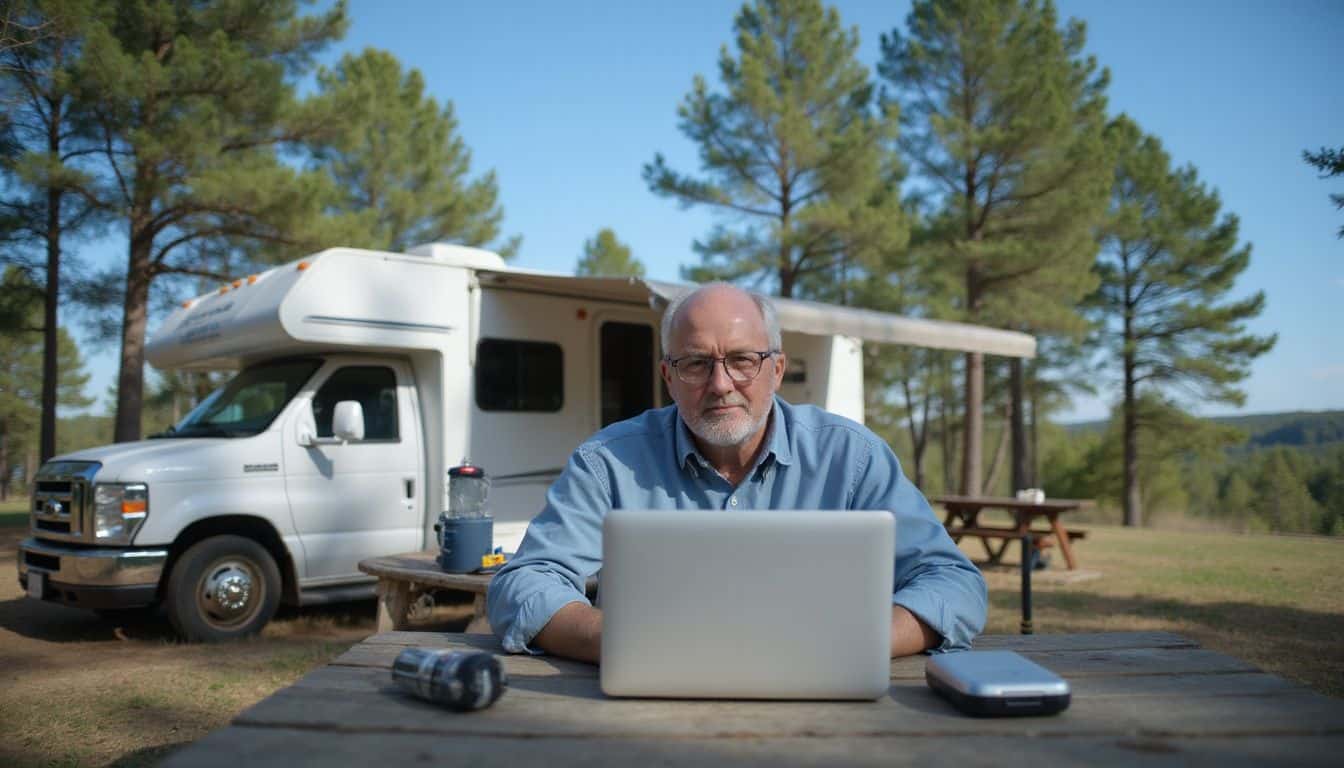
Staying connected on the road lets you work, stream shows, and keep in touch with loved ones. You’ll need a good cell signal booster, mobile hotspot, or campground Wi-Fi to check your email address and handle online tasks while enjoying your RV lifestyle.
Setting up reliable internet access
Internet access is one of the biggest expenses in full-time trailer life. I rely on a mobile hotspot to stay connected as I travel between various state parks. Good, steady service really matters, especially since I work remotely.
My Zoom meetings and webinars typically stream smoothly due to my solid cellular data plan.
Many women in our RV community prefer Starlink satellite internet in areas with weak cell coverage. The size of your RV matters too—it impacts antenna placement and gear storage options.
Always shield your equipment from harsh weather; I once had a hailstorm destroy my signal booster.
Good internet isn’t a luxury in a travel trailer – it’s the lifeline that connects you to work, family, and your next destination.
Be sure to create an email account you can check from any location. Signal boosters improve reception in rural spots with patchy service. Test your internet system carefully before hitting the road full-time.
Some campgrounds provide Wi-Fi, but it’s often slow or unreliable. Streaming movies requires more data than simply reading your emails or social media.
Managing mail and deliveries
Reliable internet keeps you connected online—but don’t forget about handling your physical mail, too. Having a solid mail management strategy can save you from endless headaches.
Many full-time RV travelers ask family members to take care of their letters and packages, but professional services offer greater flexibility. Escapees RV Club and iPostal1, for instance, offer professional mail forwarding plans for about $100 per year.
These dedicated services don’t just forward your envelopes—you’re able to log online and view your scanned mail from wherever you’re parked.
Still, the postal service has some key limitations you’ll need to keep in mind. USPS only forwards mail to one place at a time, which can turn into quite a hassle if you move around frequently.
A digital mail service like PostScan Mail solves this issue easily: they provide online management tools that are handy if your RV has limited space. Having digital mail access also helps on days of extreme weather—like unexpected hailstorms—that trap you inside your trailer.
Regular RV upkeep includes confirming your mail solution runs smoothly, giving you an easier time enjoying your travels worry-free.
Finding Places to Stay

Finding a home base ranks as a top concern for full-time trailer living. You’ll need to scout out spots that match your budget, desired amenities, and how long you plan to park your wheels.
Types of campgrounds
Private RV parks come packed with comforts like pools, Wi-Fi, and handy laundry rooms—but they tend to charge higher nightly rates. On my own road trips, these private sites were perfect for taking care of chores, relaxing, and finally grabbing a nice hot shower.
Public campgrounds, on the other hand, offer more nature views, fewer crowds, and lower fees. These campgrounds usually sit within state or national parks, and provide basic hookups along with lovely surroundings.
If you really want to save money, public lands often have completely free camping. You pay nothing to stay there, but there’s usually no hookups and stays get limited to 14 days.
RV size also plays a big role in site selection—bigger trailers simply won’t fit everywhere. Popular campgrounds tend to fill quickly, so planning ahead is key. Many national and state parks need reservations through Recreation.gov, sometimes as early as a year ahead of your trip.
Boondocking and dispersed camping
Boondocking lets you camp off-grid in beautiful, quiet places—you often won’t pay a dime. I’ve parked my trailer beneath clear, starry skies on public land, hearing nothing but wind and birdsong.
Apps like Free Campsites, Campendium, and Ultimate Campgrounds always help me find perfect camping areas far from busy crowds. My solar panels keep the lights bright, and my phone fully charged, so I can relax in peaceful surroundings.
Harvest Hosts offers a fresh option for solo women campers. They match travelers up with vineyard hosts for short overnight stays. You can wake to incredible scenery, meet friendly local people, and maybe even learn about wine.
On these adventures, I always check forecasts carefully, since a sudden hailstorm could easily damage my RV roof. What’s best is these remote camping experiences give you real travel moments that traditional campgrounds simply can’t offer.
Long-term parking options
Finding an ideal spot to park your travel trailer for weeks—or even months—takes a bit of skill. RV parks usually offer the most comfort, with electric and water hookups, laundry facilities, and sometimes extras like pools or clubhouses.
Monthly prices can swing widely, from around $400 to as high as $1,000, based on the location and available amenities. I’ve parked at RV parks that offered monthly deals, saving me nearly half compared to paying nightly rates!
Public lands provide cheaper options. National Forests and Bureau of Land Management (BLM) areas generally allow camping for up to two weeks at little or no cost. Apps like Campendium or iOverlander are my favorite tools for discovering these hidden camping areas.
They include user photos and real reviews, so there’s no guessing about what you’ll find there.
Seasonal changes often influence where you park your RV, especially to avoid rough weather that might harm your trailer. Hailstorms, for example, can cause serious damage, so keeping an eye on weather forecasts helps avoid expensive repairs.
Many full-time RV folks head south during winter months and north as summer approaches, chasing mild, easy-going weather. Parking somewhere with convenient access to RV supplies and mechanical services makes regular maintenance simpler.
Soon, we’ll talk about connecting with fellow travelers while keeping in touch with family at home.
Managing Relationships and Community
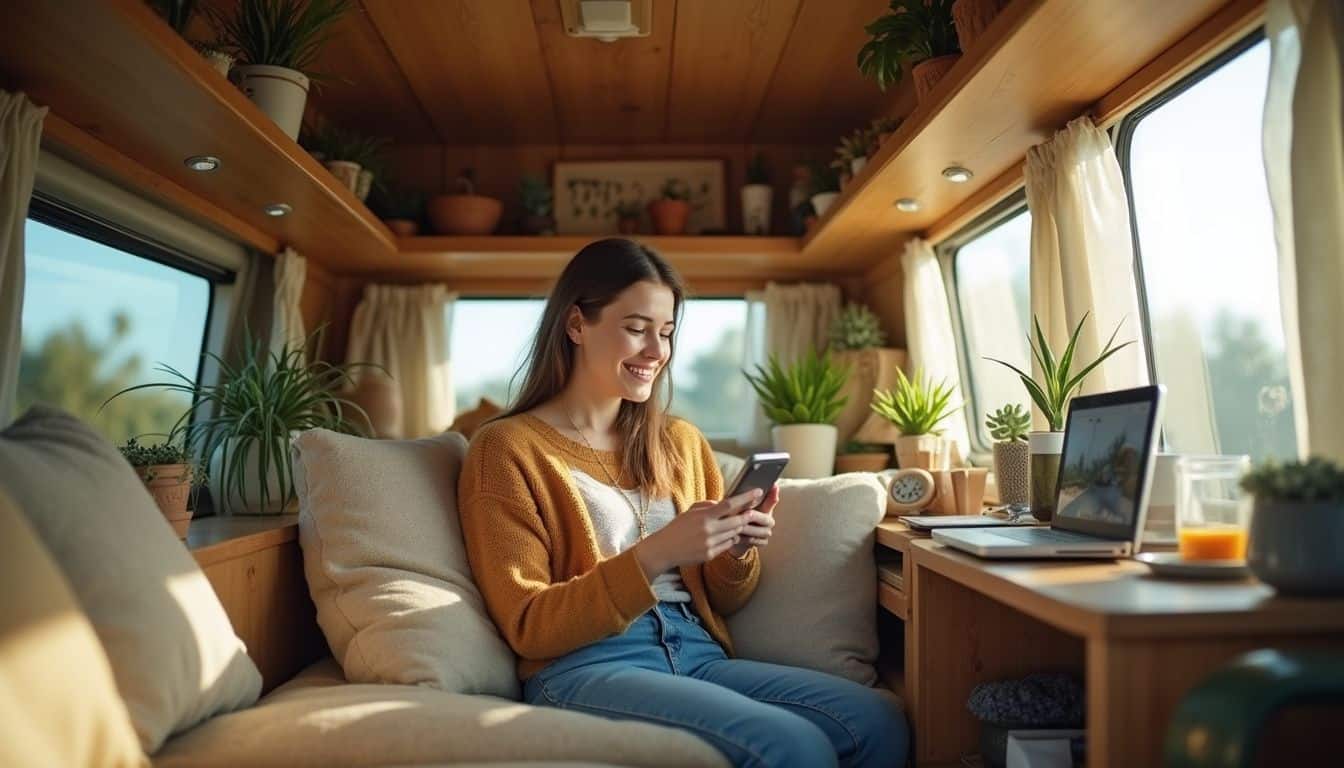
Life on the road doesn’t mean losing touch with those you care about. Smart tech tools like video calls and social media groups help you stay close to loved ones while making new friends at each stop.
Staying in touch with family and friends
Living in a travel trailer doesn’t mean losing touch with the ones you care about. In fact, traveling can help you see friends and family more easily—and even more often—than before.
Many full-time travelers notice friends visiting more regularly than they did in their previous homes. You can schedule your travel route around special occasions like weddings, reunions, or graduations.
Your mobile lifestyle can become a chance for deeper connections rather than fewer.
Having a familiar home base can offer a sense of belonging between your trips. Family and friends might even plan their visits based on your route and travel stops. This unique approach helps build stronger relationships while sharing your adventures.
Your travel trailer lifestyle can also motivate others to join in, traveling alongside you for parts of your journey, creating fun and lasting memories together on the road.
Building connections with other full-time travelers
Connecting with people on the road takes some effort—but the payoff is truly amazing. For me, joining the Fulltime Families group became a lifeline during our first year traveling in our Airstream.
The group regularly hosts events where kids get together to play, and parents trade advice on RV repairs or safe places to wait out a hailstorm. Starting a conversation may seem intimidating at first, but most travelers love meeting new people.
I usually open with a comment about someone’s RV setup or ask about interesting places they’ve visited, and friendships follow easily from there.
Camping at social-friendly RV parks increases your chances of forming lasting bonds with fellow travelers. Many parks regularly hold group activities—potluck dinners, game nights, or casual coffee gatherings—which offer easy, relaxed ways to meet neighbors.
Connecting with others online through social media can also lead to offline friendships. Last summer, we found three other families on Facebook who caravanned with us for two whole months.
Technology helps us keep these relationships alive, even after our travel routes go separate ways. Right now, we’re staying in touch by video chats with great friends we met in Florida, even though we’re currently exploring Arizona.
Tips for a Smooth Travel Day
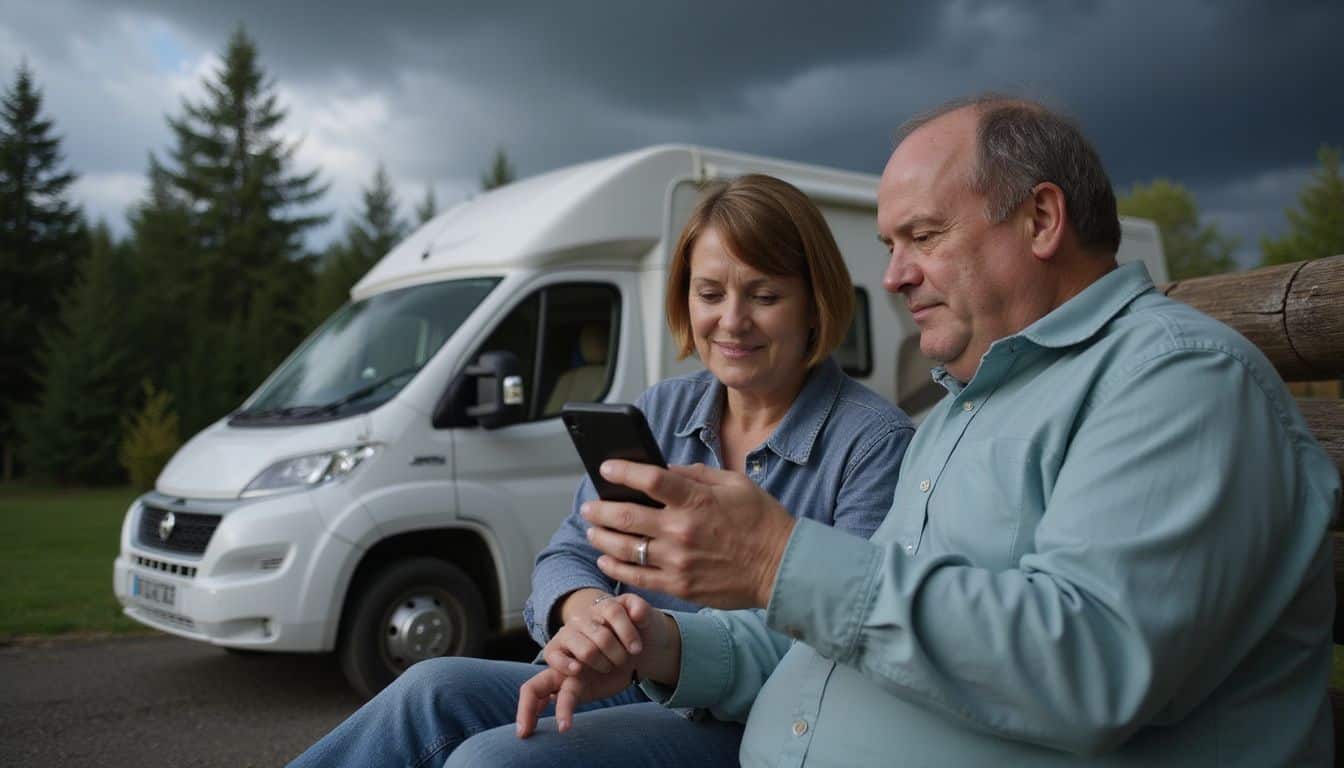
Travel days can make or break your full-time trailer living experience. Smart planning helps you dodge bad weather and find safe spots to park your rig when hail stones threaten your home on wheels.
Planning your route
Smartly planning your route cuts stress and saves money on the road. Before I set out with my trailer, I always check apps like Campendium and iOverlander. These valuable tools help me spot safe parking places and warn me about roads too narrow for my rig.
Road clearances truly matter—I once had to turn around and drive back 20 miles because of a low bridge! Give yourself extra buffer time, too. My personal rule: for every three hours on the road, I add at least one more hour to be safe.
Checking the weather is crucial to trailer safety. Last year, I skipped my usual weather check and hail severely damaged my roof. Now I’m careful to plan trips around clear weather and to steer clear of stormy seasons in risky locations.
Keeping your RV in good shape is simpler when you avoid weather-related trouble. Plan stops near service centers if maintenance is coming up soon, and always keep a second-choice spot handy, just in case your first plan falls through.
Packing efficiently
Packing smart can make travel days less stressful, especially if your home is on wheels. Before hitting the road, create a thorough checklist of necessary items. With this simple approach, you’ll avoid forgetting essentials, and you’ll maintain proper cargo weight—important, since your trailer’s weight limits directly affect its handling.
To aid stability at highway speeds, place heavier items evenly throughout storage compartments.
Keep two separate sets of everyday items like dishes and towels. One set stays packed away neatly in cabinets, while the other remains out for daily use. That strategy saves valuable packing time between stops, allowing you to get ready quickly on travel days.
Regular RV upkeep also involves reviewing your packing methods—even taking inventory. Toss out any item you haven’t touched in several months; removing unused items helps clear up extra space and ensures your trailer stays safely within weight guidelines.
Staying flexible and prepared
Life on the road calls for flexibility. Weather changes, campgrounds close unexpectedly, and your carefully planned stops can vanish in a heartbeat. Experienced travelers stay calm in these moments, always armed with a solid backup plan.
Delays and detours often creep into travel days, so leave yourself extra time—just in case. Paper maps can save the day if cell service drops, and a small tool kit lets you fix minor RV problems before they become major issues.
But smart preparation isn’t just about bringing the right stuff. A positive mindset helps you easily manage surprises and setbacks. Many trailer women who travel full time keep a handy list of other camping options within easy driving range.
They also stash some extra cash aside for sudden repairs, which often seem to crop up at the worst possible moments. Next up, we’ll cover some typical issues you’ll likely run into while living full-time in your trailer.
Common Challenges of Full-Time Travel Trailer Living
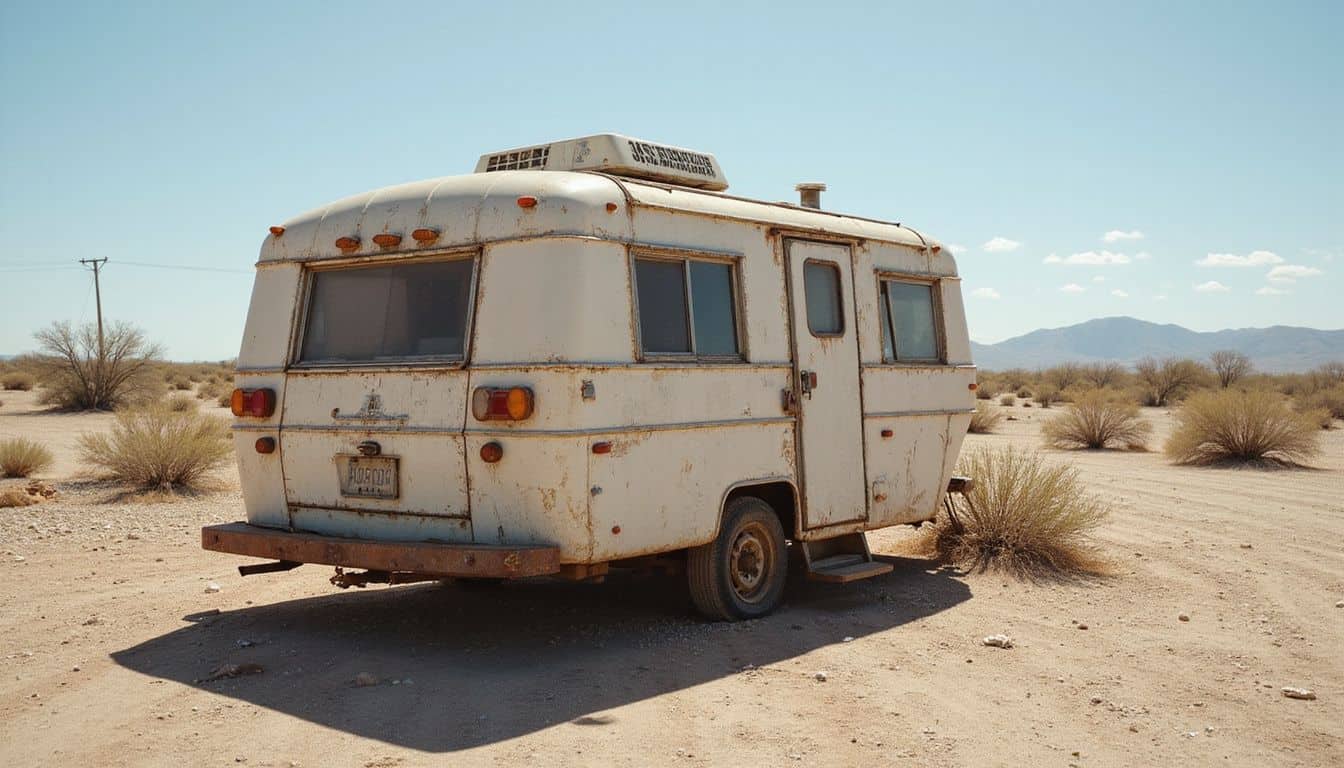
Living in a travel trailer full-time brings unique tests like sudden breakdowns and adapting to constant movement – read on to learn practical fixes for these common RV maintenance issues and how to thrive in your mobile home!
Coping with unexpected repairs
RV troubles can catch you at the worst possible moment. Expert Peggy Dent notes common headaches include black tank disasters and broken appliances. You never know when these unexpected repairs will pop up, so padding your budget is a wise move.
Many new RV owners fail to keep enough emergency cash on hand for sudden fixes. Luckily, the RV community tends to pitch in during stressful situations. Fellow campers frequently lend tools, share helpful tips, or even step up to assist in repairs.
Experienced RVers typically travel with basic tools and essential spare parts. A simple kit—including wrenches, screwdrivers, pliers, and duct tape—can truly save your trip. Knowing the basics for quick repairs in plumbing, electrical wiring, and propane systems will pay off in no time.
Most minor problems need nothing more than a quick YouTube search, a little bravery, and willingness to get your hands dirty.
It’s smart practice to set aside enough funds to cover at least one major repair every year. This cushion helps reduce anxiety, letting you relax and fully enjoy your life on the road, rather than worrying about expensive breakdowns.
Adjusting to a mobile lifestyle
Repairing broken items is just the start—getting comfortable with life on wheels can be harder. Moving from a permanent home into a traveling trailer takes some getting used to. Your home space shrinks, your daily habits shift, and every day brings a new view outside the window.
Many women find it helpful to keep a few familiar comforts around. A cozy blanket, favorite family photos, or even a beloved coffee mug, can do wonders for making your travel trailer feel like home.
Taking care of yourself matters more than ever with this lifestyle. Set aside moments every day, to enjoy peaceful or relaxing activities just for yourself. Consider joining travel groups or RV clubs, where you can connect with others who live the same way.
Friendships formed in these clubs help build a sense of belonging, even as you move from place to place. Remote jobs have also made this lifestyle easier and more realistic for many women.
With thoughtful planning and a positive attitude, the freedom of mobile living can often outweigh the initial adjustments you’ll face.
How Will Full-Time Travel Trailer Living Evolve in 2025?

Living full-time in travel trailers will likely involve longer stays by 2025. The Faiola family, for instance, intends to settle in Yuma for several months, using it as a base to explore national parks across Arizona, New Mexico, and Colorado.
More nomads are doing the same—choosing extended stays to balance steady travel with the comfort of temporary roots. Family relationships also play a big part; the Faiolas, for example, plan to host guests between February 9 and April 9, 2025.
Next year, growth opportunities for travel-trailer residents will continue to rise. Many families plan to sharpen their outdoor skills. The Faiolas will focus specifically on survival techniques and add new hiking destinations.
New business possibilities will emerge as well. The Faiola family’s ExploreMore Store, for instance, is set to bring in extra products to serve their customers better. RV and trailer specialists at men’s lifestyle website Unfinished Man say the appeal is growing for families.
It’s hard to beat the combination of freedom, affordability, and lifestyle stability these trailers offer.
People Also Ask
What are the basics needed to live in a travel trailer full time?
The basics start with a dependable travel trailer that suits your lifestyle. You’ll also need a power source—many people choose solar panels or campground electricity hookups. Water is essential, too, either from campground hookups or by regularly refilling fresh water storage tanks.
How do I handle mail and bills while living on the road?
Try a mail forwarding service to establish a steady mailing address. For bills, most full-timers move to online banking and e-billing to stay organized. You’ll find it helpful to have a reliable friend or family member check your mail occasionally, just in case something important slips through.
What clever storage hacks work best in small travel trailers?
Make the most of vertical space by adding hanging organizers and shelves. Vacuum bags are awesome—they condense clothes down to about half their original bulk. Use magnetic strips on walls to secure small metal items like keys, knives, or tools. Shower caddies aren’t just for bathrooms—they’re great for daily items, from snacks to sunscreen.
How much does full-time trailer living cost compared to a house?
Full-time trailer living usually runs about 50-75% cheaper than owning a traditional home. You’ll cut back on property taxes, utility payments, and upkeep expenses. Still, factor in campground fees and fuel—those can sometimes add up. Overall, downsizing and simple living habits offer huge savings in the end.
References
https://koa.com/blog/how-to-downsize-for-full-time-rv-living/ (2025-01-23)
https://theadventuredetour.com/2023-expert-guide-to-choose-the-best-rv-for-full-time-living/
https://barefootdetour.com/rv-renovation/
https://www.cinderstravels.com/cheap-rv-living/ (2025-03-30)
https://www.extraspace.com/blog/outdoor-recreation/how-to-make-money-while-traveling-in-an-rv/
https://www.storychasing.com/rv-living-for-beginners/ (2022-04-27)
https://changinglanesrv.com/rv-water-and-waste-management/
https://purelivingforlife.com/the-ultimate-guide-to-living-in-a-travel-trailer/
https://www.neighbor.com/storage-blog/30-rv-storage-ideas-hacks/
https://www.outdoorsy.com/blog/full-time-rv-living-guide
https://www.postscanmail.com/blog/guide-to-getting-mail-and-packages-on-the-road.html (2022-07-27)
https://twohappycampers.com/a-z-guide-to-full-time-rv-living-finding-places-to-stay/ (2023-10-26)
https://rvshare.com/blog/boondocking-expert-guide/
https://asmalllife.com/2016/08/30/park-live-rv-legally/ (2016-08-30)
https://twohappycampers.com/guide-to-full-time-rv-living-community-companionship/
https://www.fulltimefamilies.com/find-fulltime-rv-community/
https://www.nomadicmatt.com/travel-blogs/rv-travel-tips/
https://rvshare.com/blog/how-to-pack-efficiently-for-your-next-rv-trip/
https://www.shibbyrv.com/rv-packing-tips
https://www.morethanawheelin.com/7-full-time-rv-living-challenges-coping-tips/
https://rvshare.com/blog/how-to-rv-full-time/
https://thefaiolas.com/2025-our-big-plans-for-travel-growth-and-adventure/
